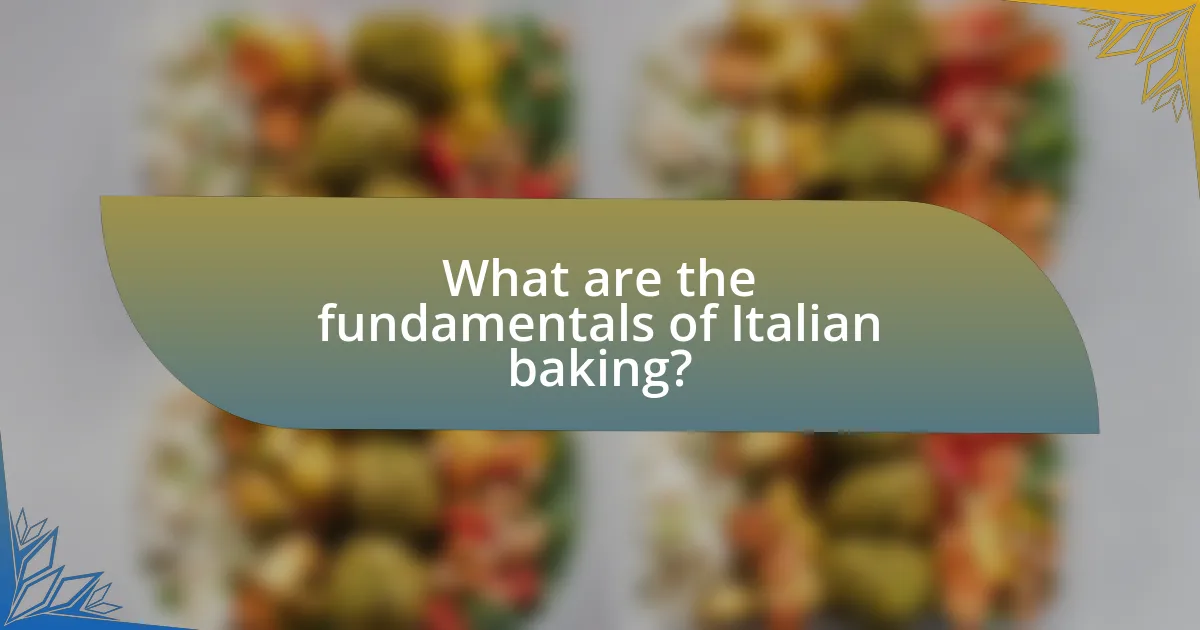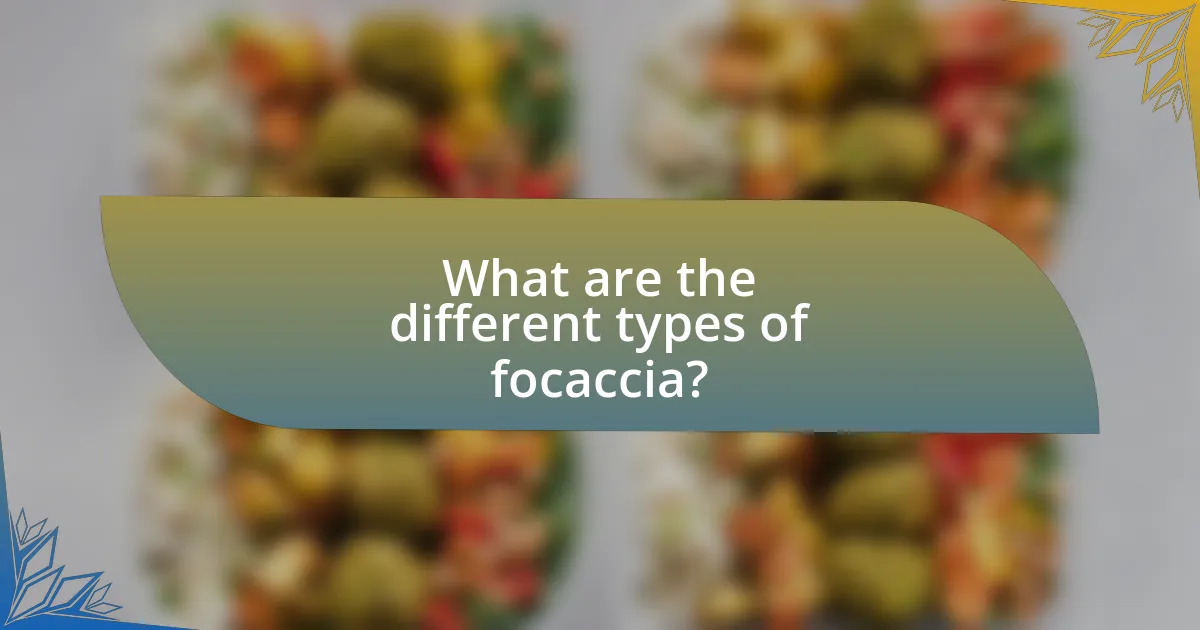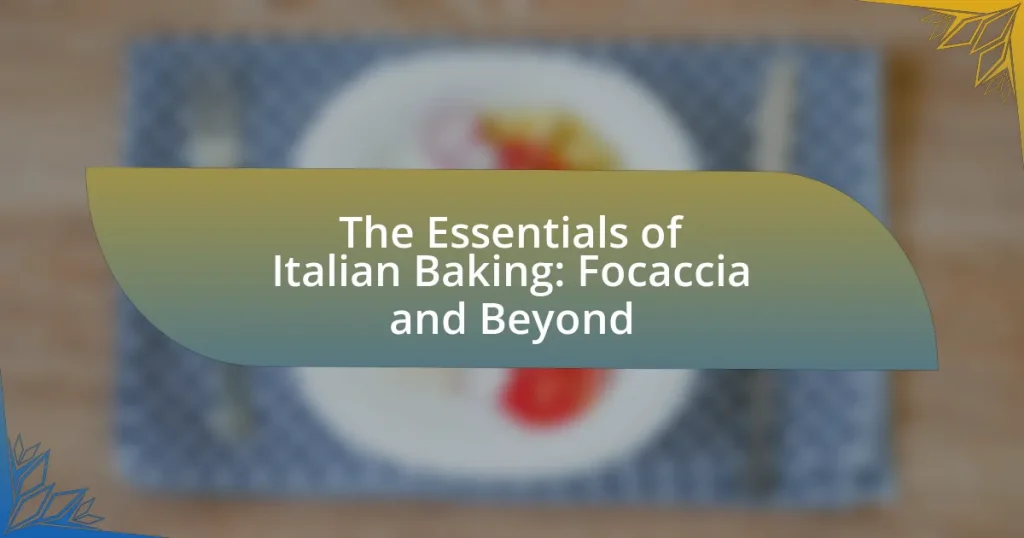The article “The Essentials of Italian Baking: Focaccia and Beyond” explores the fundamental aspects of Italian baking, emphasizing high-quality ingredients, traditional techniques, and regional variations. It highlights the significance of focaccia as a staple in Italian cuisine, detailing its historical origins, evolution, and various regional recipes. The article also discusses essential baking techniques, key ingredients, and troubleshooting tips for achieving authentic Italian baked goods, while encouraging readers to explore other traditional Italian breads and pastries. Overall, it provides a comprehensive overview of the rich culinary heritage and practices that define Italian baking.

What are the fundamentals of Italian baking?
The fundamentals of Italian baking include the use of high-quality ingredients, traditional techniques, and regional variations. High-quality flour, such as “00” flour, is essential for achieving the desired texture in breads and pastries. Traditional techniques, such as slow fermentation and the use of natural leavening agents like sourdough, enhance flavor and texture. Additionally, regional variations, such as the use of olive oil in focaccia from Liguria or the incorporation of local herbs and cheeses, reflect Italy’s diverse culinary heritage. These elements combine to create the distinctive flavors and textures characteristic of Italian baked goods.
How does Italian baking differ from other baking traditions?
Italian baking differs from other baking traditions primarily in its emphasis on simplicity and high-quality ingredients. Italian bakers often prioritize fresh, local produce, using fewer but more flavorful components, such as high-protein flour, olive oil, and natural leavening agents like sourdough. This contrasts with many other baking traditions that may incorporate a wider variety of additives and complex flavorings. For example, traditional Italian breads like focaccia and ciabatta rely on long fermentation processes to develop flavor and texture, which is a hallmark of Italian baking. Additionally, Italian pastries often feature a balance of sweetness and texture, as seen in items like cannoli and tiramisu, which focus on the quality of cream and ricotta rather than excessive sugar.
What are the key ingredients used in Italian baking?
The key ingredients used in Italian baking include flour, water, yeast, salt, and olive oil. Flour, particularly tipo “00” flour, is essential for creating the desired texture in breads and pastries. Water is crucial for hydrating the flour and activating the yeast. Yeast serves as the leavening agent, allowing the dough to rise. Salt enhances flavor and strengthens gluten structure, while olive oil adds richness and moisture to the final product. These ingredients are foundational in traditional Italian recipes, such as focaccia and pizza, which rely on their specific properties to achieve authentic taste and texture.
How do regional variations influence Italian baking styles?
Regional variations significantly influence Italian baking styles by dictating the ingredients, techniques, and types of baked goods produced in different areas. For instance, in Northern Italy, the use of butter and rice flour is prevalent, leading to products like polenta and rich pastries, while Southern Italy favors olive oil and durum wheat, resulting in lighter breads such as focaccia and ciabatta. Additionally, local traditions and climate conditions shape these baking styles; for example, the dry climate of the South allows for longer fermentation processes, enhancing flavor. Historical influences, such as the introduction of spices and techniques from trade routes, further diversify regional baking practices, making Italian baking a rich tapestry of local customs and flavors.
Why is focaccia considered a staple in Italian baking?
Focaccia is considered a staple in Italian baking due to its versatility, ease of preparation, and cultural significance. This flatbread, which dates back to ancient Roman times, serves as a base for various toppings and can be enjoyed in numerous ways, making it a fundamental part of Italian cuisine. Its widespread presence in Italian households and restaurants highlights its importance, as it is often served as an appetizer, side dish, or even a main course. The use of simple ingredients like flour, water, yeast, and olive oil reflects traditional Italian baking practices, reinforcing its status as a quintessential element of Italy’s culinary heritage.
What are the historical origins of focaccia?
Focaccia originated in ancient Rome, where it was known as “panis focacius,” a flatbread baked on the hearth. This early form of focaccia was made with simple ingredients like flour, water, and salt, reflecting the basic culinary practices of the time. Historical records indicate that focaccia evolved over centuries, particularly in the Liguria region of Italy, where it became a staple due to the availability of olive oil and herbs. The use of toppings and variations emerged during the Middle Ages, solidifying focaccia’s place in Italian cuisine.
How has focaccia evolved over time in Italy?
Focaccia has evolved significantly over time in Italy, transitioning from a simple flatbread to a diverse culinary staple. Originally, focaccia dates back to ancient Roman times, where it was made with basic ingredients like flour, water, and salt, serving as a precursor to modern bread. Over the centuries, regional variations emerged, incorporating local ingredients and flavors, such as herbs, olives, and cheeses, reflecting Italy’s rich agricultural diversity. By the Middle Ages, focaccia became a popular dish among the working class, often topped with seasonal vegetables and served as a meal. In contemporary Italy, focaccia is celebrated in various forms, including the famous focaccia di Genova, known for its airy texture and olive oil richness, and focaccia barese, which features tomatoes and olives. This evolution illustrates how focaccia has adapted to cultural and regional influences while maintaining its status as a beloved Italian bread.
What techniques are essential for successful Italian baking?
Successful Italian baking requires techniques such as proper dough hydration, fermentation control, and the use of high-quality ingredients. Proper dough hydration ensures the right texture and crumb structure, while fermentation control, including bulk fermentation and proofing, enhances flavor and texture through the development of gluten and yeast activity. High-quality ingredients, particularly flour and olive oil, contribute to the authenticity and taste of Italian baked goods. These techniques are foundational in creating traditional items like focaccia, which relies on a well-hydrated dough and adequate fermentation for its characteristic flavor and texture.
How does fermentation impact the flavor and texture of Italian breads?
Fermentation significantly enhances the flavor and texture of Italian breads by allowing yeast and bacteria to produce organic acids, alcohol, and carbon dioxide. This process contributes to a complex flavor profile, characterized by a balance of sweetness and acidity, which is essential in traditional Italian breads like ciabatta and focaccia. The carbon dioxide generated during fermentation creates air pockets, resulting in a light and airy texture, while the organic acids improve the bread’s shelf life and contribute to its chewy crust. Studies have shown that longer fermentation times lead to more pronounced flavors and improved texture, as seen in sourdough varieties, where wild yeast and lactic acid bacteria work symbiotically.
What role does kneading play in Italian baking?
Kneading plays a crucial role in Italian baking by developing gluten, which provides structure and elasticity to the dough. This process is essential for achieving the desired texture in traditional Italian breads, such as focaccia and ciabatta. The act of kneading aligns the gluten strands, allowing the dough to trap air bubbles during fermentation, which contributes to the bread’s rise and chewiness. Studies have shown that proper kneading can significantly enhance the final product’s quality, making it a fundamental technique in Italian baking.

What are the different types of focaccia?
There are several types of focaccia, including classic focaccia, focaccia al rosmarino (rosemary focaccia), focaccia di Recco (cheese-filled focaccia), and focaccia alla barese (with potatoes). Classic focaccia is characterized by its olive oil-rich dough and is often topped with coarse salt. Focaccia al rosmarino features fresh rosemary, enhancing its flavor. Focaccia di Recco is unique for its thin layers filled with cheese, originating from Liguria. Focaccia alla barese incorporates potatoes into the dough, giving it a distinct texture and flavor, typical of the Apulia region. Each type reflects regional variations and traditional ingredients, showcasing the diversity of this Italian bread.
How do variations of focaccia differ across Italy?
Variations of focaccia differ across Italy primarily in their ingredients, preparation methods, and regional toppings. For instance, in Liguria, focaccia is typically made with a high hydration dough, resulting in a soft and airy texture, often topped with olive oil and sea salt. In contrast, Apulian focaccia, known as “focaccia barese,” features a thicker crust and is often topped with tomatoes, olives, and herbs, reflecting the region’s agricultural products. Additionally, in Tuscany, focaccia is sometimes prepared with a more rustic approach, incorporating ingredients like rosemary and garlic, which are characteristic of the local cuisine. These regional differences highlight the diverse culinary traditions and local ingredients that influence focaccia across Italy.
What are the most popular regional focaccia recipes?
The most popular regional focaccia recipes include Focaccia di Genova from Liguria, Focaccia Barese from Puglia, and Focaccia al Rosmarino from Tuscany. Focaccia di Genova is characterized by its olive oil-rich dough and is often topped with coarse salt and herbs, reflecting the coastal flavors of Liguria. Focaccia Barese features a thicker, dimpled crust and is typically topped with tomatoes, olives, and sometimes potatoes, showcasing the ingredients of Puglia. Focaccia al Rosmarino is known for its simplicity, often seasoned with rosemary and sea salt, highlighting the rustic traditions of Tuscany. These recipes are celebrated for their unique regional ingredients and preparation methods, making them staples in Italian cuisine.
How can toppings enhance the flavor of focaccia?
Toppings can significantly enhance the flavor of focaccia by adding diverse tastes and textures that complement the bread’s natural flavor. For instance, toppings like rosemary and sea salt provide aromatic and savory notes, while ingredients such as olives or sun-dried tomatoes introduce briny and tangy flavors. Additionally, cheese toppings, such as mozzarella or parmesan, contribute creaminess and richness, creating a more complex flavor profile. The combination of these toppings not only elevates the overall taste but also adds visual appeal, making focaccia more enticing.
What are the best practices for baking focaccia at home?
The best practices for baking focaccia at home include using high-quality ingredients, allowing for proper fermentation, and ensuring adequate hydration in the dough. High-quality flour, such as bread flour, provides the necessary gluten structure, while using fresh yeast or sourdough starter enhances flavor and texture. Proper fermentation, typically involving a bulk rise of at least 1-2 hours followed by a second rise after shaping, allows the dough to develop flavor and airiness. Maintaining a hydration level of around 70% helps achieve the characteristic open crumb and soft texture of focaccia. Additionally, creating dimples in the dough before baking and generously drizzling olive oil enhances flavor and promotes a crispy crust. These practices are supported by traditional Italian baking methods, which emphasize the importance of ingredient quality and fermentation time in achieving authentic focaccia.
What tips can ensure a perfect focaccia texture?
To ensure a perfect focaccia texture, use high-quality flour with a protein content of around 12-14%, which contributes to gluten development. Proper hydration is crucial; aim for a dough hydration level of 70-80%, as this creates a light and airy crumb. Additionally, allow for a long fermentation period, ideally 12-24 hours, to enhance flavor and texture through natural yeast activity. Incorporating olive oil into the dough and on the surface before baking adds moisture and creates a crispy crust. Finally, bake at a high temperature, around 450°F (232°C), to achieve a golden-brown exterior while maintaining a soft interior. These techniques are supported by traditional Italian baking practices, which emphasize the importance of ingredient quality and fermentation time in achieving the desired focaccia texture.
How can one troubleshoot common focaccia baking issues?
To troubleshoot common focaccia baking issues, one should first identify the specific problem, such as insufficient rise, dense texture, or uneven baking. For insufficient rise, ensure that the yeast is fresh and properly activated; using warm water (around 110°F) can help. If the focaccia is dense, it may be due to over-kneading or not allowing enough time for the dough to rise; a gentle knead and adequate proofing time are essential. For uneven baking, check that the oven is preheated and use an oven thermometer to confirm the temperature, as an inaccurate oven can lead to inconsistent results. These troubleshooting steps are supported by baking science, which emphasizes the importance of yeast activity, dough handling, and temperature control in achieving optimal results.

What other Italian baked goods should one explore?
One should explore Italian baked goods such as ciabatta, panettone, and cannoli. Ciabatta is a rustic bread known for its crispy crust and airy texture, originating from the region of Tuscany. Panettone is a traditional sweet bread loaf, typically enjoyed during Christmas, characterized by its dome shape and filled with candied fruits and raisins. Cannoli are pastry shells filled with sweet ricotta cheese, originating from Sicily, and are often garnished with chocolate chips or pistachios. Each of these baked goods represents a unique aspect of Italian culinary tradition, showcasing regional ingredients and techniques.
What are some traditional Italian breads beyond focaccia?
Some traditional Italian breads beyond focaccia include ciabatta, pane di Altamura, and pane casereccio. Ciabatta is known for its rustic appearance and chewy texture, originating from the region of Tuscany. Pane di Altamura, made from durum wheat, is a traditional bread from Puglia, recognized for its unique flavor and long shelf life. Pane casereccio, or country bread, varies by region but is typically made with a mix of flours and has a thick crust and soft interior, reflecting local baking traditions. These breads are integral to Italian cuisine and showcase the diversity of Italian baking.
How do ciabatta and pane di Altamura compare to focaccia?
Ciabatta and pane di Altamura differ from focaccia primarily in texture and preparation methods. Ciabatta is characterized by its rustic, chewy crust and open crumb structure, achieved through high hydration dough and minimal kneading. Pane di Altamura, made from durum wheat, has a denser texture and a nutty flavor, resulting from its unique flour and traditional baking methods. In contrast, focaccia is known for its flat, soft, and airy texture, often topped with olive oil, herbs, and other ingredients, which distinguishes it from the more bread-like qualities of ciabatta and pane di Altamura. These differences highlight the diverse baking techniques and regional ingredients that define Italian bread.
What unique characteristics define Italian pastries?
Italian pastries are characterized by their diverse textures, rich flavors, and regional variations. These pastries often feature a delicate balance of sweetness and creaminess, with ingredients such as ricotta, mascarpone, and various fruits. Traditional Italian pastries, like cannoli and tiramisu, showcase a combination of crispy and soft elements, often enhanced by the use of high-quality ingredients like fresh eggs and artisanal flour. Additionally, many Italian pastries are influenced by local customs and seasonal ingredients, resulting in unique offerings across different regions of Italy. For example, the Sicilian cassata incorporates layers of sponge cake, ricotta, and candied fruit, reflecting the island’s culinary heritage.
How can one incorporate Italian baking techniques into everyday cooking?
To incorporate Italian baking techniques into everyday cooking, one can start by mastering the art of making focaccia, which involves using high-quality flour, a long fermentation process, and generous amounts of olive oil for flavor and texture. This technique not only enhances the bread’s taste but also improves its digestibility, as seen in traditional Italian practices where dough is allowed to rise slowly, often overnight. Additionally, applying the method of using a pizza stone can replicate the high heat of a traditional wood-fired oven, resulting in a crisp crust for homemade pizzas. These techniques are rooted in Italian culinary traditions, which emphasize quality ingredients and patience in the baking process, leading to superior flavor and texture in everyday dishes.
What are some simple Italian baking recipes for beginners?
Some simple Italian baking recipes for beginners include Focaccia, Pizza Bianca, and Biscotti. Focaccia is an easy bread that requires basic ingredients like flour, water, yeast, and olive oil, making it accessible for novice bakers. Pizza Bianca, a simple flatbread topped with olive oil and salt, also uses similar ingredients and can be customized with herbs. Biscotti, a twice-baked cookie, is straightforward to prepare and only requires flour, sugar, eggs, and almonds. These recipes are foundational in Italian baking and provide a great starting point for beginners.
How can one adapt Italian baking methods for modern kitchens?
To adapt Italian baking methods for modern kitchens, one can utilize digital kitchen scales for precise measurements, which enhances accuracy in ingredient ratios. Traditional Italian baking often relies on weight rather than volume, making this adaptation crucial for achieving authentic results. Additionally, using convection ovens can replicate the high heat of traditional wood-fired ovens, allowing for better crust development in breads like focaccia. Incorporating stand mixers can streamline the kneading process, which is essential for developing gluten in doughs. These adaptations maintain the integrity of Italian baking while accommodating contemporary kitchen tools and techniques.
What are the essential tips for mastering Italian baking?
To master Italian baking, focus on using high-quality ingredients, understanding fermentation, and practicing traditional techniques. High-quality flour, such as “00” flour, is essential for achieving the right texture in breads and pastries. Understanding fermentation, particularly with sourdough starters or biga, enhances flavor and texture, as seen in classic Italian breads like ciabatta. Practicing traditional techniques, such as hand-kneading and proper shaping, ensures authenticity and skill development. These elements are foundational in Italian baking, as they contribute to the distinct flavors and textures characteristic of Italian baked goods.
How can one develop a deeper understanding of Italian baking culture?
To develop a deeper understanding of Italian baking culture, one should immerse themselves in the traditional practices and regional variations of Italian baking. Engaging with authentic Italian cookbooks, such as “The Silver Spoon,” which details over 2,000 recipes, provides insight into the techniques and ingredients used across different regions. Additionally, participating in hands-on baking classes, particularly those focused on iconic items like focaccia and panettone, allows for practical experience and cultural exchange. Visiting local bakeries in Italy, where artisans often share their knowledge and stories, further enriches this understanding. Historical context, such as the significance of bread in Italian culture, exemplified by the phrase “il pane è vita” (bread is life), underscores the cultural importance of baking in Italy.
What resources are available for learning more about Italian baking?
Books, online courses, and cooking blogs are valuable resources for learning about Italian baking. Notable books include “The Italian Baker” by Carol Field, which provides authentic recipes and techniques, and “Bread and Wine” by Ruth Reichl, which explores the cultural significance of Italian bread. Online platforms like MasterClass offer courses taught by renowned chefs, such as Massimo Bottura, focusing on traditional Italian baking methods. Additionally, popular cooking blogs like “The Kitchn” and “Serious Eats” feature articles and recipes that delve into various Italian baked goods, providing step-by-step guidance and tips. These resources collectively offer a comprehensive understanding of Italian baking techniques and recipes.















